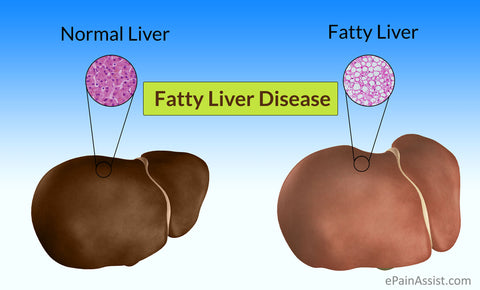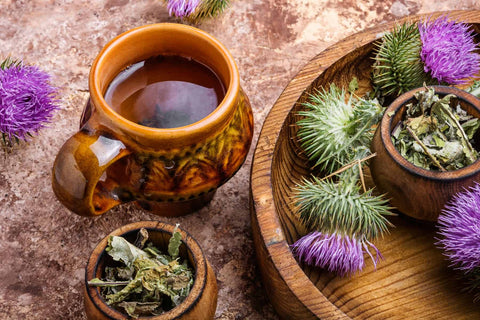Fatty liver disease has been increasing over time due to excess alcohol consumption and/or bad lifestyle habits. There are many herbs with promising medicinal properties, and a few herbs have excellent liver-protecting properties. Dandelion and milk thistle are two such herbs that, when combined, can speed up the process of healing. You must know these few things about fatty liver, dandelion, and milk thistle for fatty liver.

What Is Fatty Liver Disease (NAFLD)?

Fatty liver disease can be because of two reasons - alcoholic and nonalcoholic. Alcoholic fatty liver is caused due to excess consumption of alcohol as the name suggests, whereas, in nonalcoholic fatty liver disease, alcohol isn’t involved. Nonalcoholic fatty liver disease or NAFLD is defined as hepatic steatosis, where fat cell accumulation in the liver takes place. Inflammation, obesity, insulin resistance, excess oxidative stress, and mitochondrial dysfunction may co-exist with NAFLD. Some researchers doubt that NAFLD may be related to type - 2 diabetes or metabolic syndrome and cardiovascular disease or CVD.
Dandelion for Fatty Liver Disease
Dandelion root is well-known when it comes to liver health. It has been used for centuries to strengthen and tone the liver. Herbs that benefit the liver are known as hepatics and burdock root and dandelion root are a few in the list. It helps increase bile flow as it also acts as cholagogue or choleretic. Cholagogue’s help in bile production and its flow. Dandelion reduces inflammation and congestion of the liver. It also acts as a diuretic and reduces water retention in the body. It acts as an antirheumatic preventing muscular complications, a laxative with rich nutrients, and a tonic.

There are various articles published that state the effects of dandelion root on the liver. Due to its tremendous hepatic benefits, it is called a hepatic antioxidant type herb. It also reduces peroxidation of the liver and speeds up the healing process. Dandelion root also reduces lipid peroxidation and cholesterol levels in the liver by reducing oxidative stress. Another study found that this root can protect the reaction to toxicity caused by alcohol in the liver. It can also promote anti-oxidant effects and reduce lipid peroxidation in the liver.
What Is Milk Thistle?
Milk thistle belongs to the family daisies belonging to, and these grow in the Mediterranean regions. It is a purple-flowered plant with white veins on them. There is a traditional Christian story behind these white veins. It is said that these are due to the fall of a milk drop from the Virgin Mary. Milk thistle leaves and seeds are used as herbal remedies to many health ailments. It is specifically known to treat chronic liver conditions, including fatty liver disease.
Different parts of this milk thistle plant are used to treat various health problems. The most common liver ailments treated with milk thistle are liver cirrhosis, hepatitis C, jaundice, and gallbladder disorders. Milk thistle also protects the heart by lowering cholesterol levels in the blood and manages blood sugar levels in type - 2 diabetes.

Only if the NAFLD patients make changes to their lifestyle habits by increasing physical workout, eating healthy, and losing weight can prevent nonalcoholic fatty steatohepatitis or liver cirrhosis (NASH).
Researchers have conducted many studies, among which one was published in the journal “Medicine.” This was on alternative medicine to look for therapeutic properties and its effectiveness as hepatic enzymes. Silymarin is a group of active compounds in milk thistle extract. This study indicates that the liver predisposes individuals with NAFLD to other metabolic disorders.
Eight random clinical trials were made on 587 NAFLD patients who took silymarin. Few took silymarin supplements of 70 mg to 80 mg thrice a day, while others took only once a day. Another study used 540 mg of silymarin twice a day. Based on all these studies, the authors concluded that 70 mg of silymarin thrice a day or 140 mg twice a day has the best therapeutic effect. All the patients have seemed to tolerate the doses well.
Based on lower AST and ALT levels among NAFLD patients who took silymarin supplements compared to those who didn’t, authors have concluded that silymarin may reinvigorate the liver. This may even reduce the chances of progressing to liver cirrhosis.
However, these authors have not mentioned any drug interactions, while silymarin may interact with certain drugs. Thus, it is essential to check if you take any medicine that may interact with silymarin. More research is going on the same.
Dandelion And Milk Thistle for Fatty Liver
With the help of active compounds, silymarin in milk thistle, and dandelion root, NAFLD patients can increase the chances of treating chronic liver diseases like fatty liver or NAFLD.

Dandelion and milk thistle can be used together in many ways, and one among these is tea. The difficulty and time consumption of making a cup of dandelion and milk thistle tea depends on the product you choose. If you choose dandelion leaves, chop them, and if you use roots, clean them and use them as they are. It is also available in the form of powder and tea bags, using which would be easy. If you use milk thistle seeds, you need to crush them well into a smooth powder. Chop if you use milk thistle leaves. This is also available in the form of powder and tea bags.
Due to many possible side effects, one shouldn’t start taking it without checking for them. There are contraindications for both dandelions and milk thistle. Check if you fall under any of them. Please talk with your doctor before taking it.
Start with just a cup of dandelion and milk thistle tea a day and observe for side effects. If there is any side effect, try to rectify it, else gradually increase the number of cups up to 3 cups a day. Sometimes, excess dosage may cause side effects in some people. Take one to two cups a day in that case. Make sure to observe the effects.
